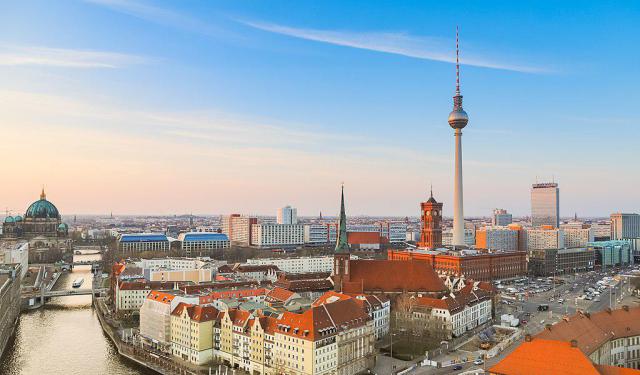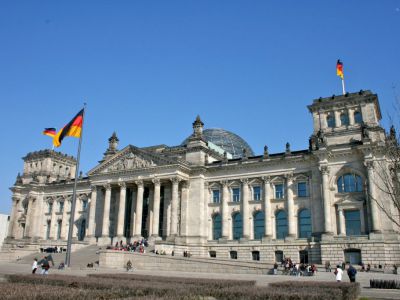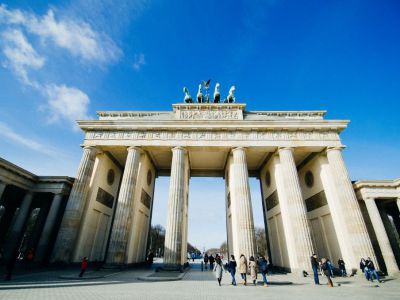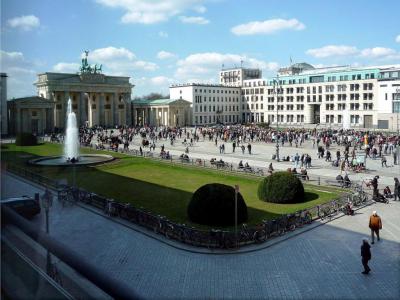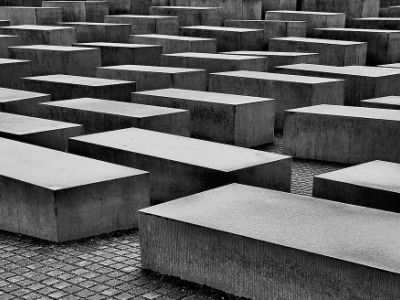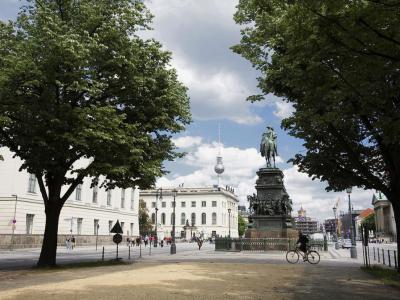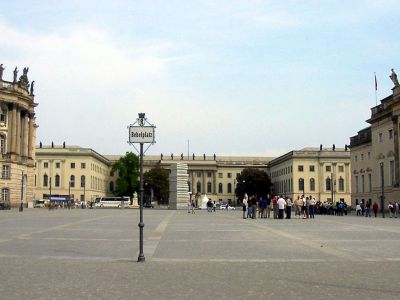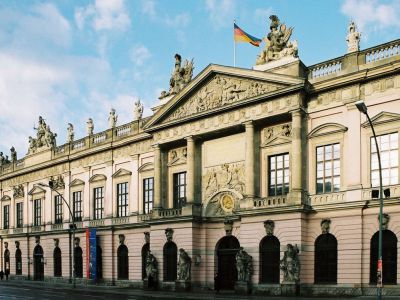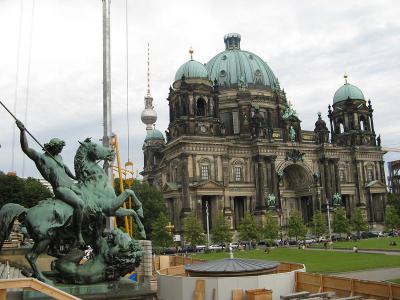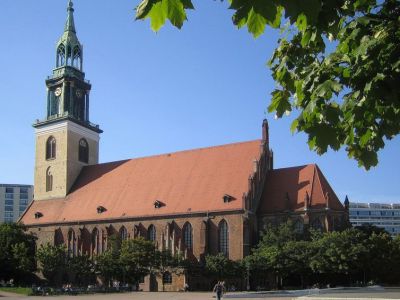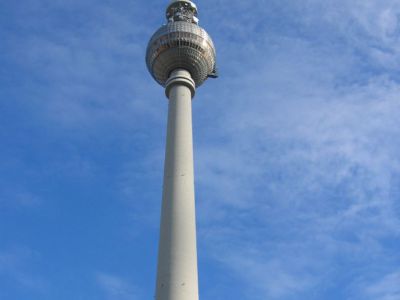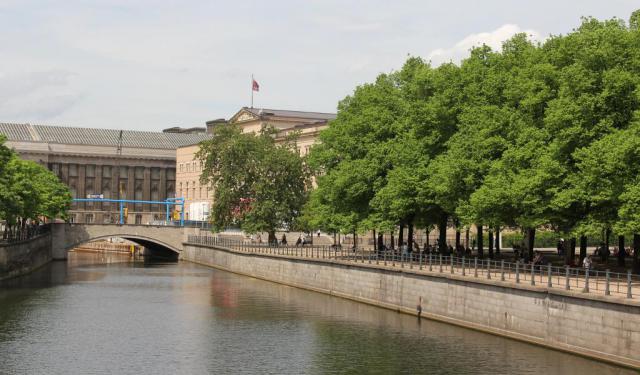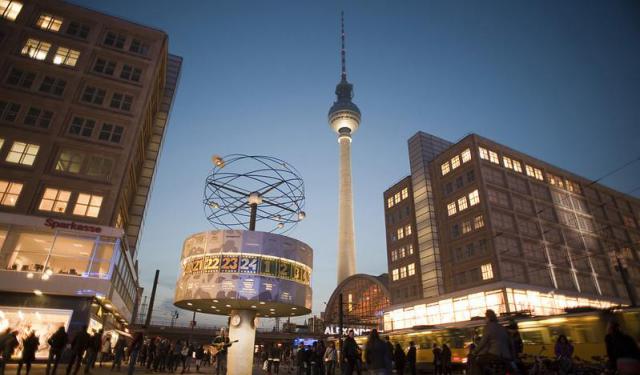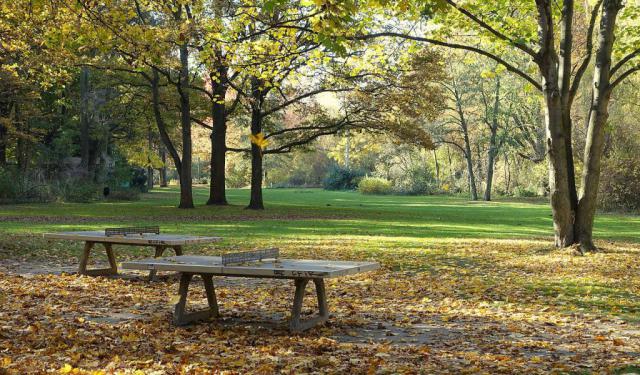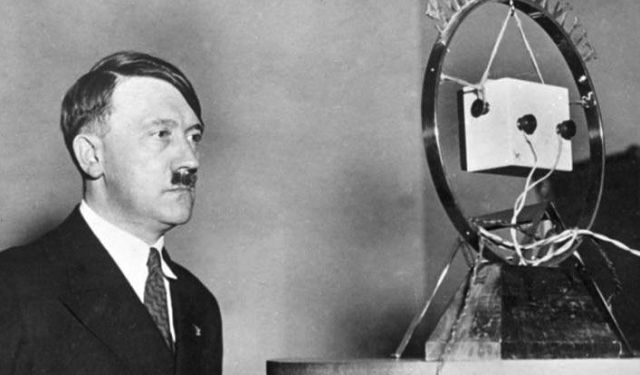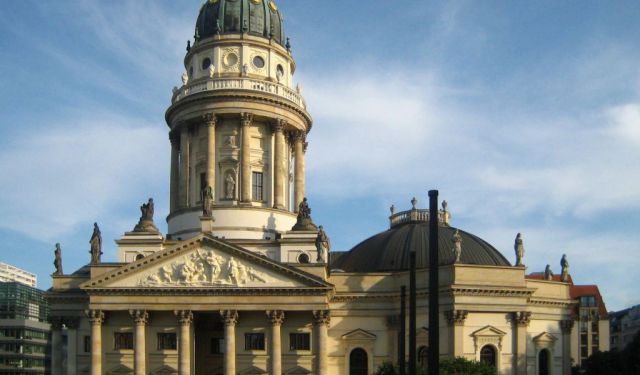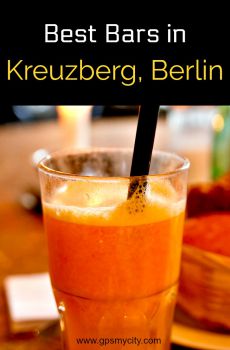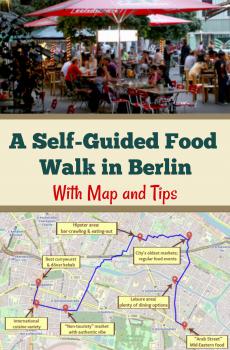Audio Guide: Berlin Introduction Walking Tour (Self Guided), Berlin
The German capital, Berlin, is known for its turbulent past. Today, this sprawling metropolis is filled with a mix of historical resonance and modernity manifested in creative industries, popular media, and diverse cultural tourism.
The first written records of settlements in the present-day Berlin area date back to the late 12th century. In 1157, the region came under German rule as part of the Margraviate of Brandenburg, founded by Albert the Bear. Berlin, as a town, was mentioned for the first time in 1251. While the origin of its name is uncertain, popular belief links it to the German word for bear, which is also reflected in the city's coat of arms bequeathed by Albert the Bear.
Berlin flourished as the capital of Prussia since 1701. In the 19th century, Under Chancellor Bismarck, it became a hub of European politics. After World War I, postwar struggles and the Great Depression of the 1930s fueled the rise of Nazism. During the Nazi regime, from 1933 to 1945, Hitler envisioned Berlin as a world capital. Allied occupation following World War II saw Berlin split into East and West. From 1961 to 1989, the Berlin Wall separated the two, making West Berlin an exclave of West Germany, while East Berlin became East Germany's capital.
Nowadays, starting at the refurbished Reichstag building, whose glass dome represents transparency in governance, you can trace the political shifts that defined the city. For almost three decades during the Cold War, the 18th-century Brandenburg Gate, obstructed by the Berlin Wall, served as the marker of the city's division. Following the Fall of the Berlin Wall in 1989, Berlin once again emerged as the capital of unified Germany.
A short walk from the gate, the Holocaust Memorial is a place for reflection and a stark reminder of the country's not-so-distant history and tragedy of World War II.
Following the Unter den Linden boulevard, a major thoroughfare running through Berlin's heart, you’ll encounter Bebel Square, a location forever marked by the infamous book burning of 1933. Nearby, the German Historical Museum provides an in-depth look into Germany’s past, while the Berlin Cathedral adds a touch of Baroque to the city’s skyline. And of course, you can’t miss the emblematic TV Tower, Berlin’s tallest structure from the 1960s, on Alexander Square.
Berlin’s centuries-long history has given rise to a vibrant cultural landscape. If you're ready to explore it, the German capital is calling, with each corner telling a new chapter of a story that is far from over. So, come and be part of Berlin’s narrative-where history meets the present, and the future is constantly being written.
The first written records of settlements in the present-day Berlin area date back to the late 12th century. In 1157, the region came under German rule as part of the Margraviate of Brandenburg, founded by Albert the Bear. Berlin, as a town, was mentioned for the first time in 1251. While the origin of its name is uncertain, popular belief links it to the German word for bear, which is also reflected in the city's coat of arms bequeathed by Albert the Bear.
Berlin flourished as the capital of Prussia since 1701. In the 19th century, Under Chancellor Bismarck, it became a hub of European politics. After World War I, postwar struggles and the Great Depression of the 1930s fueled the rise of Nazism. During the Nazi regime, from 1933 to 1945, Hitler envisioned Berlin as a world capital. Allied occupation following World War II saw Berlin split into East and West. From 1961 to 1989, the Berlin Wall separated the two, making West Berlin an exclave of West Germany, while East Berlin became East Germany's capital.
Nowadays, starting at the refurbished Reichstag building, whose glass dome represents transparency in governance, you can trace the political shifts that defined the city. For almost three decades during the Cold War, the 18th-century Brandenburg Gate, obstructed by the Berlin Wall, served as the marker of the city's division. Following the Fall of the Berlin Wall in 1989, Berlin once again emerged as the capital of unified Germany.
A short walk from the gate, the Holocaust Memorial is a place for reflection and a stark reminder of the country's not-so-distant history and tragedy of World War II.
Following the Unter den Linden boulevard, a major thoroughfare running through Berlin's heart, you’ll encounter Bebel Square, a location forever marked by the infamous book burning of 1933. Nearby, the German Historical Museum provides an in-depth look into Germany’s past, while the Berlin Cathedral adds a touch of Baroque to the city’s skyline. And of course, you can’t miss the emblematic TV Tower, Berlin’s tallest structure from the 1960s, on Alexander Square.
Berlin’s centuries-long history has given rise to a vibrant cultural landscape. If you're ready to explore it, the German capital is calling, with each corner telling a new chapter of a story that is far from over. So, come and be part of Berlin’s narrative-where history meets the present, and the future is constantly being written.
How it works: Download the app "GPSmyCity: Walks in 1K+ Cities" from Apple App Store or Google Play Store to your mobile phone or tablet. The app turns your mobile device into a personal tour guide and its built-in GPS navigation functions guide you from one tour stop to next. The app works offline, so no data plan is needed when traveling abroad.
Berlin Introduction Walking Tour Map
Guide Name: Berlin Introduction Walking Tour
Guide Location: Germany » Berlin (See other walking tours in Berlin)
Guide Type: Self-guided Walking Tour (Sightseeing)
# of Attractions: 10
Tour Duration: 2 Hour(s)
Travel Distance: 4.0 Km or 2.5 Miles
Author: DanaOffice
Sight(s) Featured in This Guide:
Guide Location: Germany » Berlin (See other walking tours in Berlin)
Guide Type: Self-guided Walking Tour (Sightseeing)
# of Attractions: 10
Tour Duration: 2 Hour(s)
Travel Distance: 4.0 Km or 2.5 Miles
Author: DanaOffice
Sight(s) Featured in This Guide:
- Reichstag (Parliament Building)
- Brandenburger Tor (Brandenburg Gate)
- Pariser Platz (Paris Square)
- Holocaust Denkmal (Holocaust Memorial)
- Unter den Linden (Under the Lime Trees Boulevard)
- Bebelplatz (Bebel Square)
- Deutsches Historisches Museum (German Historical Museum)
- Berliner Dom (Berlin Cathedral)
- Marienkirche (Saint Mary's Church)
- Fernsehturm (TV Tower)
1) Reichstag (Parliament Building) (must see)
Reichstag is one of Berlin’s most enduring symbols. Its stone walls have borne witness to the tides of history, mirroring Germany’s tumultuous political evolution: from imperial unification, through dictatorship and division, to a modern democratic republic.
Once referring to the legislative body of the German Empire, today, the word “Reichstag” more commonly denotes the iconic building housing the country's parliament, Bundestag.
Following the unification of Germany in 1871, plans were laid to construct a grand hall for the newly formed state (“Second Reich”). Completed in 1894, the Neo-Baroque structure was intended to reflect the strength and unity of the empire. In 1916, amidst a world at war and against the wishes of Emperor Wilhelm II, the inscription-"To the German People"-was carved into the frieze above the entrance. Just two years later, with the empire dissolved, it was within these very walls that the German Republic was proclaimed.
In 1933, a fire engulfed the Reichstag-a blaze which the Nazi regime would exploit to issue the infamous decree, suspending civil liberties and consolidating authoritarian power. Thereafter, the building was no longer used for parliamentary functions during the Nazi era and instead served various other roles throughout the war.
The Second World War left the Reichstag in ruins. During the Cold War, the fractured remains of the building stood on the western side of a divided Berlin. Though no longer a seat of government, it occasionally hosted exhibitions, ceremonies, and even concerts during the 1980s.
Then, on the historic night of October 3rd, 1990, the Reichstag reclaimed its national significance. Within its restored chamber, the ceremony marking the official reunification of Germany was held-attended by Chancellor Helmut Kohl and numerous statesmen.
In the mid-1990s, the British architect Sir Norman Foster was commissioned to redesign the building. His intervention preserved historical scars-including Soviet graffiti etched in 1945-while introducing a strikingly modern glass dome. Completed in 1999, the dome serves as a powerful architectural metaphor for democratic transparency. Open to the public, it allows visitors to peer down into the debating chamber below, while its 360-degree panorama reveals the vast expanse of the capital. A sun-tracking shield ensures natural light floods the space without overwhelming glare.
Tip:
Plan your visit in advance, as security measures require booking and a valid ID for entry.
For those wishing to skip the queue, reserving a table at the Käfer DACHGARTEN restaurant provides expedited access.
Dress warmly-while the dome offers breathtaking views, its open windows invite Berlin’s brisk winds.
Once referring to the legislative body of the German Empire, today, the word “Reichstag” more commonly denotes the iconic building housing the country's parliament, Bundestag.
Following the unification of Germany in 1871, plans were laid to construct a grand hall for the newly formed state (“Second Reich”). Completed in 1894, the Neo-Baroque structure was intended to reflect the strength and unity of the empire. In 1916, amidst a world at war and against the wishes of Emperor Wilhelm II, the inscription-"To the German People"-was carved into the frieze above the entrance. Just two years later, with the empire dissolved, it was within these very walls that the German Republic was proclaimed.
In 1933, a fire engulfed the Reichstag-a blaze which the Nazi regime would exploit to issue the infamous decree, suspending civil liberties and consolidating authoritarian power. Thereafter, the building was no longer used for parliamentary functions during the Nazi era and instead served various other roles throughout the war.
The Second World War left the Reichstag in ruins. During the Cold War, the fractured remains of the building stood on the western side of a divided Berlin. Though no longer a seat of government, it occasionally hosted exhibitions, ceremonies, and even concerts during the 1980s.
Then, on the historic night of October 3rd, 1990, the Reichstag reclaimed its national significance. Within its restored chamber, the ceremony marking the official reunification of Germany was held-attended by Chancellor Helmut Kohl and numerous statesmen.
In the mid-1990s, the British architect Sir Norman Foster was commissioned to redesign the building. His intervention preserved historical scars-including Soviet graffiti etched in 1945-while introducing a strikingly modern glass dome. Completed in 1999, the dome serves as a powerful architectural metaphor for democratic transparency. Open to the public, it allows visitors to peer down into the debating chamber below, while its 360-degree panorama reveals the vast expanse of the capital. A sun-tracking shield ensures natural light floods the space without overwhelming glare.
Tip:
Plan your visit in advance, as security measures require booking and a valid ID for entry.
For those wishing to skip the queue, reserving a table at the Käfer DACHGARTEN restaurant provides expedited access.
Dress warmly-while the dome offers breathtaking views, its open windows invite Berlin’s brisk winds.
2) Brandenburger Tor (Brandenburg Gate) (must see)
The Brandenburg Gate is the last standing part of the western side of the Customs Wall that surrounded Berlin in the 18th century. It marks a monumental entry to Unter den Linden, the famed boulevard lined with lime trees that once led to the palace of the Prussian monarchs.
This neoclassical landmark was built between 1788 and 1791 during the reign of King Frederick William II of Prussia. Inspired by Roman triumphal arches and the classical Greek gateway to the Acropolis of Athens, the gate has twelve fluted Doric columns flanked by two pavilions originally occupied by guards, as well as five passageways, and reliefs depicting the Labors of Hercules. Its crowning glory is the bronze Quadriga sculpture – the goddess of victory atop a four-horsed chariot, originally regarded as a symbol of peace.
Throughout its history, the gate has played a crucial role in Germany's political narrative. In 1806, during the French occupation, Napoleon ordered its dismantling and transportation to Paris. However, upon its return in 1814, after Napolean's defeat, the gate was declared a symbol of victory, and the goddess was adorned with the Prussian eagle and iron cross, symbolizing triumph. The structure has stood witness to many pivotal events in Berlin's history, from military parades to the rise of the Third Reich and Hitler's ascent to power, upon which it was used as a Nazi propaganda symbol.
The Brandenburg Gate also holds memories of the Fall of Berlin and the Russian flag's raising in May 1945. After World War II, it stood damaged but intact and became part of the Soviet occupation zone. During the Cold War era, the gate – blocked by the Berlin Wall from 1961 until the fall of the Berlin Wall in 1989 – remained in no-man's land between East and West Germany. Back then, it served as a defining symbol of Berlin's and Germany’s division and their eventual reunification.
Today, the Brandenburg Gate is a venue for commemorations and public events. Apart from being a photo-op, its historical importance is just as good a reason to visit.
Tip:
Consider visiting at night when the gate is beautifully illuminated and less crowded, allowing for contemplation of its storied past and symbolic value.
This neoclassical landmark was built between 1788 and 1791 during the reign of King Frederick William II of Prussia. Inspired by Roman triumphal arches and the classical Greek gateway to the Acropolis of Athens, the gate has twelve fluted Doric columns flanked by two pavilions originally occupied by guards, as well as five passageways, and reliefs depicting the Labors of Hercules. Its crowning glory is the bronze Quadriga sculpture – the goddess of victory atop a four-horsed chariot, originally regarded as a symbol of peace.
Throughout its history, the gate has played a crucial role in Germany's political narrative. In 1806, during the French occupation, Napoleon ordered its dismantling and transportation to Paris. However, upon its return in 1814, after Napolean's defeat, the gate was declared a symbol of victory, and the goddess was adorned with the Prussian eagle and iron cross, symbolizing triumph. The structure has stood witness to many pivotal events in Berlin's history, from military parades to the rise of the Third Reich and Hitler's ascent to power, upon which it was used as a Nazi propaganda symbol.
The Brandenburg Gate also holds memories of the Fall of Berlin and the Russian flag's raising in May 1945. After World War II, it stood damaged but intact and became part of the Soviet occupation zone. During the Cold War era, the gate – blocked by the Berlin Wall from 1961 until the fall of the Berlin Wall in 1989 – remained in no-man's land between East and West Germany. Back then, it served as a defining symbol of Berlin's and Germany’s division and their eventual reunification.
Today, the Brandenburg Gate is a venue for commemorations and public events. Apart from being a photo-op, its historical importance is just as good a reason to visit.
Tip:
Consider visiting at night when the gate is beautifully illuminated and less crowded, allowing for contemplation of its storied past and symbolic value.
3) Pariser Platz (Paris Square)
Once the outskirts of Berlin, today this grand square pulsates with life and is a vibrant hub at the core of Berlin. Situated immediately behind the Brandenburg Gate, Paris Square marks the western end of Unter den Linden, the capital's ceremonial axis, down which the victorious troops of all regimes, from the Imperial to those of the German Democratic Republic, have marched in triumph.
The square was laid out between 1732 and 1735 and was originally known as Quarrel or Direct Square. In March 1814, it was renamed after the French capital to commemorate the victorious alliance over Napoleon and the subsequent occupation of France by the Allied forces, including the Prussian army.
Before World War II, Paris Square was the grandest in Berlin, flanked by remarkable structures, including the American and French embassies, the finest in town Adlon Hotel, the Arts Academy, and several blocks of apartments and offices.
During the last years of World War II, the ravages of heavy artillery bombardment and air raids turned the surrounding buildings into rubble. The only structure that remained standing was the Brandenburg Gate. After the war and especially with the construction of the Berlin Wall, the square was laid waste and became part of the dead zone dividing the city.
Following Germany’s reunification in 1990, efforts were made to restore the square to its former grandeur. Embassies returned, the hotel and arts academy were rebuilt, and new buildings were designed to respect traditional heights and styles. The square is now framed by the Dresdner Bank building and the French Embassy on the north side, while the US Embassy, DZ Bank head office, and the Academy of Fine Arts line the south. The Hotel Adlon, restored to its former glory, stands to the east, symbolizing Berlin’s hospitality once again.
In addition to its historical significance, Paris Square is also a perfect spot for photographs of the Brandenburg Gate and a starting point for exploring the Unter den Linden Boulevard.
Tip:
Consider visiting early in the morning or late at night to enjoy the place in solitude. Alternatively, sneak into the DZ Bank to get a glimpse of some fascinating architecture or visit the Max-Liebermann-Haus, next to the gate, to view exhibitions with paintings from the 1920s.
The square was laid out between 1732 and 1735 and was originally known as Quarrel or Direct Square. In March 1814, it was renamed after the French capital to commemorate the victorious alliance over Napoleon and the subsequent occupation of France by the Allied forces, including the Prussian army.
Before World War II, Paris Square was the grandest in Berlin, flanked by remarkable structures, including the American and French embassies, the finest in town Adlon Hotel, the Arts Academy, and several blocks of apartments and offices.
During the last years of World War II, the ravages of heavy artillery bombardment and air raids turned the surrounding buildings into rubble. The only structure that remained standing was the Brandenburg Gate. After the war and especially with the construction of the Berlin Wall, the square was laid waste and became part of the dead zone dividing the city.
Following Germany’s reunification in 1990, efforts were made to restore the square to its former grandeur. Embassies returned, the hotel and arts academy were rebuilt, and new buildings were designed to respect traditional heights and styles. The square is now framed by the Dresdner Bank building and the French Embassy on the north side, while the US Embassy, DZ Bank head office, and the Academy of Fine Arts line the south. The Hotel Adlon, restored to its former glory, stands to the east, symbolizing Berlin’s hospitality once again.
In addition to its historical significance, Paris Square is also a perfect spot for photographs of the Brandenburg Gate and a starting point for exploring the Unter den Linden Boulevard.
Tip:
Consider visiting early in the morning or late at night to enjoy the place in solitude. Alternatively, sneak into the DZ Bank to get a glimpse of some fascinating architecture or visit the Max-Liebermann-Haus, next to the gate, to view exhibitions with paintings from the 1920s.
4) Holocaust Denkmal (Holocaust Memorial) (must see)
Officially named The Memorial to the Murdered Jews of Europe, this solemn expanse of concrete, situated near Berlin’s Brandenburg Gate, stands as a stark and enduring tribute to the millions of Jewish lives extinguished under the Nazi regime between the years 1933 and 1945.
Unveiled in 2005, the memorial was conceived by American architect Peter Eisenman. It spans nearly 19,000 square meters and consists of more than 2,700 concrete stelae-each of varying height and dimension-arranged in a strict grid across a subtly sloping field. The result is a landscape that is simultaneously orderly and disorienting.
Though the design is intentionally abstract and, according to its creator, devoid of explicit symbolism, its resemblance to a graveyard is unmistakable. Some interpret the sea of grey pillars as evoking unmarked graves or the cold efficiency of a bureaucratic system that facilitated mass murder. Others see in its rigid structure a metaphor for a state that lost its humanity behind walls of administration and ideology.
As one moves deeper into the memorial, the concrete blocks grow taller, eclipsing the cityscape and swallowing sound. The sensation is deliberate. It conveys isolation, loss of identity, and the disorienting fear that accompanied the systematic persecution of Jews under the Third Reich. The path dips downward, suggesting the slow descent into darkness that defined those years.
The unfinished quality of some surfaces serves as a quiet reminder: remembrance is not complete, and history’s wounds do not fully heal. The fragmentation of space may reflect the fragmented memories of survivors-and of those lost, whose stories were never told.
This memorial does not offer resolution or unity. It does not attempt to console. Instead, it confronts. It calls forth reflection-on individual memory, on collective guilt, and on the enduring responsibility to remember, in a world where forgetting is all too easy...
Unveiled in 2005, the memorial was conceived by American architect Peter Eisenman. It spans nearly 19,000 square meters and consists of more than 2,700 concrete stelae-each of varying height and dimension-arranged in a strict grid across a subtly sloping field. The result is a landscape that is simultaneously orderly and disorienting.
Though the design is intentionally abstract and, according to its creator, devoid of explicit symbolism, its resemblance to a graveyard is unmistakable. Some interpret the sea of grey pillars as evoking unmarked graves or the cold efficiency of a bureaucratic system that facilitated mass murder. Others see in its rigid structure a metaphor for a state that lost its humanity behind walls of administration and ideology.
As one moves deeper into the memorial, the concrete blocks grow taller, eclipsing the cityscape and swallowing sound. The sensation is deliberate. It conveys isolation, loss of identity, and the disorienting fear that accompanied the systematic persecution of Jews under the Third Reich. The path dips downward, suggesting the slow descent into darkness that defined those years.
The unfinished quality of some surfaces serves as a quiet reminder: remembrance is not complete, and history’s wounds do not fully heal. The fragmentation of space may reflect the fragmented memories of survivors-and of those lost, whose stories were never told.
This memorial does not offer resolution or unity. It does not attempt to console. Instead, it confronts. It calls forth reflection-on individual memory, on collective guilt, and on the enduring responsibility to remember, in a world where forgetting is all too easy...
5) Unter den Linden (Under the Lime Trees Boulevard)
Unter den Linden, which means “Under the Lime Trees” in English, is a historic boulevard in the heart of Berlin, running east-west from the Berlin Palace to Paris Square and Brandenburg Gate.
The street was originally established as a bridle path, in the 16th century, by the Prince-Elector John George of Brandenburg to access his hunting grounds in the Tiergarten. It was later transformed into a tree-lined boulevard, in the 17th century, by Electress Dorothea Sophie, who initiated the development of a new suburb named in her honor.
Over time, Unter den Linden became a key part of Berlin’s urban expansion, connecting major streets, like Friedrich Street and Wilhelm Street, and serving as a central axis through the city. It was designed to resemble the grand boulevards of Paris and became known as Berlin's most renowned street by the 19th century.
During World War II, the lime trees along the boulevard were destroyed but then replanted in the 1950s.
Landmarks such as the Berlin Cathedral, Bebel Square, and Humboldt University line the Unter den Linden. Other notable sites include the Old Commandant's Office (at Number 1), the German Historical Museum (at Number 2), the Crown Prince's Palace (at Number 3), and the Berlin State Library (at Number 8). At the western end of the street are the Russian and Hungarian Embassies. Also, adorning the boulevard are a number of statues such as those of the Humboldt brothers, Alexander and Wilhelm, who were prominent scientists, and several Prussian generals.
You can also find multiple cafés, restaurants, upscale shops, and even luxury car dealerships like Bentley and Mercedes-Benz. Often teeming with tourists and students exploring the book stalls around Humboldt University and the State Library, Unter den Linden serves as the backdrop for many outdoor events.
Taking a leisurely stroll along this broad avenue is a fine pastime that offers a good feel of both German history and contemporary trends. So, lace up your walking shoes and immerse yourself!
Tip:
If you visit in September or October, be sure to catch the Festival of Lights, which transforms landmarks and buildings across the city through the use of illuminations, luministic projections, and 3D mapping.
The street was originally established as a bridle path, in the 16th century, by the Prince-Elector John George of Brandenburg to access his hunting grounds in the Tiergarten. It was later transformed into a tree-lined boulevard, in the 17th century, by Electress Dorothea Sophie, who initiated the development of a new suburb named in her honor.
Over time, Unter den Linden became a key part of Berlin’s urban expansion, connecting major streets, like Friedrich Street and Wilhelm Street, and serving as a central axis through the city. It was designed to resemble the grand boulevards of Paris and became known as Berlin's most renowned street by the 19th century.
During World War II, the lime trees along the boulevard were destroyed but then replanted in the 1950s.
Landmarks such as the Berlin Cathedral, Bebel Square, and Humboldt University line the Unter den Linden. Other notable sites include the Old Commandant's Office (at Number 1), the German Historical Museum (at Number 2), the Crown Prince's Palace (at Number 3), and the Berlin State Library (at Number 8). At the western end of the street are the Russian and Hungarian Embassies. Also, adorning the boulevard are a number of statues such as those of the Humboldt brothers, Alexander and Wilhelm, who were prominent scientists, and several Prussian generals.
You can also find multiple cafés, restaurants, upscale shops, and even luxury car dealerships like Bentley and Mercedes-Benz. Often teeming with tourists and students exploring the book stalls around Humboldt University and the State Library, Unter den Linden serves as the backdrop for many outdoor events.
Taking a leisurely stroll along this broad avenue is a fine pastime that offers a good feel of both German history and contemporary trends. So, lace up your walking shoes and immerse yourself!
Tip:
If you visit in September or October, be sure to catch the Festival of Lights, which transforms landmarks and buildings across the city through the use of illuminations, luministic projections, and 3D mapping.
6) Bebelplatz (Bebel Square)
Formerly and colloquially still referred to as Opera Square, this spot in the central Mitte district of Berlin bears the name of August Bebel, a 19th-century founder of the Social Democratic Party of Germany. The square consists of a green area to the east and an open area to the west of the State Opera House, to which it owes its prewar name.
The square was originally laid out between 1741 and 1743 under King Frederick II of Prussia, as part of his so-called Frederick's Forum plan. Due to opposition from his cousin, Frederick William, the plan was scaled down, and the square ended up smaller than initially intended. Still, it was surrounded by notable buildings such as the State Opera, Saint Hedwig's Cathedral, and the Old Library. Originally named Opera Square, it was renamed Kaiser Franz Josef Square in 1910 in honor of the Austrian Emperor’s 80th birthday.
Unfortunately, in the 20th century, this square became eternally ill-famed as the site of one of the most infamous attempts to erase knowledge in the history of mankind. Here, on the evening of 10 May 1933, the nationalist German Student Association burned around 20,000 books that they deemed objectionable from the university library. Whipped up into a frenzy by the Nazi Propaganda Minister Joseph Goebbels' speech, members of the Nazi Students' League, SA, SS, and Hitler Youth set ablaze the works by renowned authors like Heinrich Mann, Erich Maria Remarque, Karl Marx, and Albert Einstein.
The "Empty Library" poignant memorial – consisting of a glass-enclosed view into an underground chamber with empty bookshelves – created by Micha Ullman, at the heart of the square, commemorates the event. Nearby, is a prophetic quote from Heinrich Heine, warning that where books are burned, people will eventually be burned too.
Heavily damaged during World War II, the square was renamed Bebel Square in 1947 and fully restored in the 1950s. Today, the layout of Bebel Square remains largely unchanged, with many of its historical buildings reconstructed, preserving the architectural legacy of the 18th century. These include the swanky Hotel de Rome.
Visiting in the evening or late afternoon is recommended, as the illumination enhances the visibility of the memorial on the ground, reminding of the profound consequences of intolerance and hatred.
The square was originally laid out between 1741 and 1743 under King Frederick II of Prussia, as part of his so-called Frederick's Forum plan. Due to opposition from his cousin, Frederick William, the plan was scaled down, and the square ended up smaller than initially intended. Still, it was surrounded by notable buildings such as the State Opera, Saint Hedwig's Cathedral, and the Old Library. Originally named Opera Square, it was renamed Kaiser Franz Josef Square in 1910 in honor of the Austrian Emperor’s 80th birthday.
Unfortunately, in the 20th century, this square became eternally ill-famed as the site of one of the most infamous attempts to erase knowledge in the history of mankind. Here, on the evening of 10 May 1933, the nationalist German Student Association burned around 20,000 books that they deemed objectionable from the university library. Whipped up into a frenzy by the Nazi Propaganda Minister Joseph Goebbels' speech, members of the Nazi Students' League, SA, SS, and Hitler Youth set ablaze the works by renowned authors like Heinrich Mann, Erich Maria Remarque, Karl Marx, and Albert Einstein.
The "Empty Library" poignant memorial – consisting of a glass-enclosed view into an underground chamber with empty bookshelves – created by Micha Ullman, at the heart of the square, commemorates the event. Nearby, is a prophetic quote from Heinrich Heine, warning that where books are burned, people will eventually be burned too.
Heavily damaged during World War II, the square was renamed Bebel Square in 1947 and fully restored in the 1950s. Today, the layout of Bebel Square remains largely unchanged, with many of its historical buildings reconstructed, preserving the architectural legacy of the 18th century. These include the swanky Hotel de Rome.
Visiting in the evening or late afternoon is recommended, as the illumination enhances the visibility of the memorial on the ground, reminding of the profound consequences of intolerance and hatred.
7) Deutsches Historisches Museum (German Historical Museum) (must see)
The German Historical Museum, known by the acronym DHM, describes itself as a place of "enlightenment and understanding of the shared history of Germans and Europeans." Often viewed as one of the most important museums in Berlin, it is also one of its most frequented. The museum is located in the Baroque-style Armory building, the oldest on the Unter den Linden, which was completed in 1706.
The DHM was established on 28 October 1987, to commemorate Berlin’s 750th anniversary, and was inaugurated inside the Reichstag. The idea for the museum was supported by Federal Chancellor Helmut Kohl, who considered it a national priority. A committee of historians developed the museum’s concept, emphasizing a multi-perspective approach to German history in an international context.
The DHM was originally planned to be built near the Reichstag. However, the fall of the Berlin Wall in 1989 changed plans, and the museum was moved to the historic Armory on Unter den Linden. This transition was completed in 1991. The Armory underwent extensive restoration from 1994 to 1998 and saw a new hall – for temporary exhibitions, spanning four floors – designed by Chinese-American architect I M Pei.
In addition to it, the museum also features a specialized research library with over 225,000 volumes, including rare books and museum catalogs, housed in a building that previously served as the Prussian Central Cooperative Bank and later a GDR state-run company. The museum’s cinema offers a program focusing on historical and film-historical themes through exhibitions and retrospectives. Since 2004, it has been a venue for the Berlin International Film Festival’s "Retrospective and Homage" screenings.
Inaugurated by Chancellor Angela Merkel in 2006, the museum's Permanent Exhibition remains a key institution for understanding Germany’s past in a global context. Comprehensive explanations for the exhibits are available in both German and English, making it worth a few hours' investment for those intrigued by in-depth German and European history.
Editor's Note:
The Armory is closed for essential renovations and the renewal of the Permanent Exhibition since June 28, 2021. It is expected to reopen to visitors at the end of 2025.
The DHM was established on 28 October 1987, to commemorate Berlin’s 750th anniversary, and was inaugurated inside the Reichstag. The idea for the museum was supported by Federal Chancellor Helmut Kohl, who considered it a national priority. A committee of historians developed the museum’s concept, emphasizing a multi-perspective approach to German history in an international context.
The DHM was originally planned to be built near the Reichstag. However, the fall of the Berlin Wall in 1989 changed plans, and the museum was moved to the historic Armory on Unter den Linden. This transition was completed in 1991. The Armory underwent extensive restoration from 1994 to 1998 and saw a new hall – for temporary exhibitions, spanning four floors – designed by Chinese-American architect I M Pei.
In addition to it, the museum also features a specialized research library with over 225,000 volumes, including rare books and museum catalogs, housed in a building that previously served as the Prussian Central Cooperative Bank and later a GDR state-run company. The museum’s cinema offers a program focusing on historical and film-historical themes through exhibitions and retrospectives. Since 2004, it has been a venue for the Berlin International Film Festival’s "Retrospective and Homage" screenings.
Inaugurated by Chancellor Angela Merkel in 2006, the museum's Permanent Exhibition remains a key institution for understanding Germany’s past in a global context. Comprehensive explanations for the exhibits are available in both German and English, making it worth a few hours' investment for those intrigued by in-depth German and European history.
Editor's Note:
The Armory is closed for essential renovations and the renewal of the Permanent Exhibition since June 28, 2021. It is expected to reopen to visitors at the end of 2025.
8) Berliner Dom (Berlin Cathedral) (must see)
Despite what its lofty name suggests, the Berlin Cathedral is... not a cathedral. Yep, never was. Because Berlin never had a Catholic bishop in the house.
Now, rewind to 1451, when Prince-Elector Frederick II-nicknamed "Iron-tooth" because, well, medieval PR was wild-built a castle chapel right here. It started out Catholic, then switched to Lutheran in 1539, and just to keep things spicy, went Calvinist by 1608.
The version we see today is a Neo-Renaissance stunner, built between 1894 and 1905 by order of Emperor Wilhelm II, who basically wanted his very own Protestant answer to the Vatican’s Saint Peter’s Basilica. And what a power move it was: 114 meters long, 73 wide, and 116 tall-this place made everything else in Berlin look like dollhouse furniture.
And it wasn’t just for show, either. The Hohenzollerns-Germany’s royal family-worshipped here and even used the crypt as their final resting place. That lasted until 1918, when Wilhelm II peaced out to the Netherlands after abdicating the throne.
Then came World War II, and let’s just say the cathedral did not come out looking its best. East Germany did some repairs-thanks, GDR-but also tore down the Memorial Church in 1975, which wasn’t their finest hour.
Fast forward to 1993, and voilà: the place got a full glow-up. It now has the majestic pipe organ, pristine acoustics, priceless art, and vibes so divine they practically echo. Today, it’s home to choirs galore, including the English Choir Berlin, which hosts monthly Choral Evensong in true Anglican style.
If you're feeling brave, you can climb the dome! There’s a roomy stairwell, plenty of landings to catch your breath-and yes, actual chairs if you need a moment. At the bottom, history buffs rejoice: the crypt holds 94 royal sarcophagi. It's like Prussian Netflix, but... quieter.
Tip:
Snag the audio guide-it’s a small fee for a big info boost. Or grab a printed guide if you're old school. And in the summer, feel free to stretch out on the lawn across the street, near the fountain. It's the perfect picnic spot, and the cathedral makes a dramatic lunch backdrop.
Now, rewind to 1451, when Prince-Elector Frederick II-nicknamed "Iron-tooth" because, well, medieval PR was wild-built a castle chapel right here. It started out Catholic, then switched to Lutheran in 1539, and just to keep things spicy, went Calvinist by 1608.
The version we see today is a Neo-Renaissance stunner, built between 1894 and 1905 by order of Emperor Wilhelm II, who basically wanted his very own Protestant answer to the Vatican’s Saint Peter’s Basilica. And what a power move it was: 114 meters long, 73 wide, and 116 tall-this place made everything else in Berlin look like dollhouse furniture.
And it wasn’t just for show, either. The Hohenzollerns-Germany’s royal family-worshipped here and even used the crypt as their final resting place. That lasted until 1918, when Wilhelm II peaced out to the Netherlands after abdicating the throne.
Then came World War II, and let’s just say the cathedral did not come out looking its best. East Germany did some repairs-thanks, GDR-but also tore down the Memorial Church in 1975, which wasn’t their finest hour.
Fast forward to 1993, and voilà: the place got a full glow-up. It now has the majestic pipe organ, pristine acoustics, priceless art, and vibes so divine they practically echo. Today, it’s home to choirs galore, including the English Choir Berlin, which hosts monthly Choral Evensong in true Anglican style.
If you're feeling brave, you can climb the dome! There’s a roomy stairwell, plenty of landings to catch your breath-and yes, actual chairs if you need a moment. At the bottom, history buffs rejoice: the crypt holds 94 royal sarcophagi. It's like Prussian Netflix, but... quieter.
Tip:
Snag the audio guide-it’s a small fee for a big info boost. Or grab a printed guide if you're old school. And in the summer, feel free to stretch out on the lawn across the street, near the fountain. It's the perfect picnic spot, and the cathedral makes a dramatic lunch backdrop.
9) Marienkirche (Saint Mary's Church)
Berlin's Saint Mary's Church is one of the oldest in town. Its exact age is uncertain, but it was first mentioned in chronicles in 1292. Originally a Roman Catholic church, it became Lutheran after the Reformation in 1539 and later joined the Prussian Union of Churches.
The unassuming fusion of architectural styles somehow renders it one of Berlin's most appealing churches; its simplicity is a reminder of the city's humble beginnings. The oldest parts of the church are made of granite, while the majority of it is built of red brick, mirroring the design of the nearby Berlin City Hall. Severely damaged during World War II, Saint Mary’s was located in East Berlin after the war and was restored by East German authorities in the 1950s.
Once hemmed in by neighboring buildings, Saint Mary's now stands in solitude, casting its shadow beneath the imposing TV Tower. Outside the building is a statue of Martin Luther, with his right hand touching one of the Bible's pages as if uttering his renowned phrase, "by faith alone." Meanwhile, the church's interior – an excellent place to escape the buzz – reveals a rather austere Gothic design punctuated by notable Baroque embellishments.
Of particular note is the pulpit adorned with elaborately carved cherubs wielding trumpets and the baptismal font supported by three black dragon-shaped legs. In terms of carving and gilding, the restored organ tops it all off, and visitors can enjoy rousing recitals on Thursdays and Fridays, typically accompanied by an invitation to closely examine the 18th-century instrument.
Upon entering, brace yourself for a surprise: a 22-meter-tall frieze titled "The Dance of Death", commemorating the plague epidemics that wreaked havoc during the Dark Ages. Also inside, visitors can view the monumental tombs of a Prussian general field marshal and the founder of the world’s oldest Biblical society.
Tips:
Photography enthusiasts can find an ideal vantage point with a reflective fountain layout in the square, just behind the TV Tower, offering a perfect reflection of the church on the water's surface.
The unassuming fusion of architectural styles somehow renders it one of Berlin's most appealing churches; its simplicity is a reminder of the city's humble beginnings. The oldest parts of the church are made of granite, while the majority of it is built of red brick, mirroring the design of the nearby Berlin City Hall. Severely damaged during World War II, Saint Mary’s was located in East Berlin after the war and was restored by East German authorities in the 1950s.
Once hemmed in by neighboring buildings, Saint Mary's now stands in solitude, casting its shadow beneath the imposing TV Tower. Outside the building is a statue of Martin Luther, with his right hand touching one of the Bible's pages as if uttering his renowned phrase, "by faith alone." Meanwhile, the church's interior – an excellent place to escape the buzz – reveals a rather austere Gothic design punctuated by notable Baroque embellishments.
Of particular note is the pulpit adorned with elaborately carved cherubs wielding trumpets and the baptismal font supported by three black dragon-shaped legs. In terms of carving and gilding, the restored organ tops it all off, and visitors can enjoy rousing recitals on Thursdays and Fridays, typically accompanied by an invitation to closely examine the 18th-century instrument.
Upon entering, brace yourself for a surprise: a 22-meter-tall frieze titled "The Dance of Death", commemorating the plague epidemics that wreaked havoc during the Dark Ages. Also inside, visitors can view the monumental tombs of a Prussian general field marshal and the founder of the world’s oldest Biblical society.
Tips:
Photography enthusiasts can find an ideal vantage point with a reflective fountain layout in the square, just behind the TV Tower, offering a perfect reflection of the church on the water's surface.
10) Fernsehturm (TV Tower) (must see)
The Berlin Television Tower was built by East Germany in the late 1960s. Inaugurated on October 3, 1969, it is the tallest structure in Germany and the third-tallest in the European Union.
Designated as a monument in 1979, the tower attracts around 1.2 million visitors annually and is one of Germany’s top tourist attractions. It has an observation deck at 203 meters and the rotating restaurant “Sphere” at 207 meters, offering panoramic views of the city, extending up to 40 kilometers (or 25 miles) on a clear day.
The tower’s height increased from 365 to 368 meters in 1997 after a new antenna was added, making it the fourth tallest free-standing structure in Europe, surpassed only by Moscow's Ostankino Tower and TV towers in Kiev and Riga. If you have a mild fear of heights, fear not-the elevator whisks you to the top in a mere 40 seconds. You can also opt for a more adventurous ascent via 985 steps.
Inside, enjoy the authentic Sputnik-era ambiance complete with period-appropriate decor and finishes. If you have specific dietary preferences, particularly as a vegetarian, it's advisable to peruse the restaurant menu on their website before making a reservation. The dining experience itself is quite lovely otherwise, comprising a starter, main course, and dessert, plus a glass of sparkling wine and two glasses of red or white wine, along with unlimited water. Moreover, the restaurant rotates slowly, affording you a comprehensive view of Berlin, making it an ideal setting for photography. A full rotation takes about half an hour, offering ample opportunity to capture the city from a bird's-eye perspective while sipping a coffee.
Presently dubbed "the toothpick" by locals, the tower previously earned the nickname “Pope’s Revenge” because sunlight reflecting off its dome forms a Greek cross, which some saw as a rebuke to East Germany’s anti-religious stance, and was mentioned by the former US president Ronald Reagan in his 1987 “Tear down this wall” speech. For the same reasons, it was also jokingly called "Saint Walter" after Walter Ulbricht, leader of the Socialist Unity Party which governed East Germany.
Originally a symbol of Communist power, the TV tower is now a unified Berlin landmark and a cultural and tourist icon, hosting events like the Festival of Lights.
Designated as a monument in 1979, the tower attracts around 1.2 million visitors annually and is one of Germany’s top tourist attractions. It has an observation deck at 203 meters and the rotating restaurant “Sphere” at 207 meters, offering panoramic views of the city, extending up to 40 kilometers (or 25 miles) on a clear day.
The tower’s height increased from 365 to 368 meters in 1997 after a new antenna was added, making it the fourth tallest free-standing structure in Europe, surpassed only by Moscow's Ostankino Tower and TV towers in Kiev and Riga. If you have a mild fear of heights, fear not-the elevator whisks you to the top in a mere 40 seconds. You can also opt for a more adventurous ascent via 985 steps.
Inside, enjoy the authentic Sputnik-era ambiance complete with period-appropriate decor and finishes. If you have specific dietary preferences, particularly as a vegetarian, it's advisable to peruse the restaurant menu on their website before making a reservation. The dining experience itself is quite lovely otherwise, comprising a starter, main course, and dessert, plus a glass of sparkling wine and two glasses of red or white wine, along with unlimited water. Moreover, the restaurant rotates slowly, affording you a comprehensive view of Berlin, making it an ideal setting for photography. A full rotation takes about half an hour, offering ample opportunity to capture the city from a bird's-eye perspective while sipping a coffee.
Presently dubbed "the toothpick" by locals, the tower previously earned the nickname “Pope’s Revenge” because sunlight reflecting off its dome forms a Greek cross, which some saw as a rebuke to East Germany’s anti-religious stance, and was mentioned by the former US president Ronald Reagan in his 1987 “Tear down this wall” speech. For the same reasons, it was also jokingly called "Saint Walter" after Walter Ulbricht, leader of the Socialist Unity Party which governed East Germany.
Originally a symbol of Communist power, the TV tower is now a unified Berlin landmark and a cultural and tourist icon, hosting events like the Festival of Lights.
Walking Tours in Berlin, Germany
Create Your Own Walk in Berlin
Creating your own self-guided walk in Berlin is easy and fun. Choose the city attractions that you want to see and a walk route map will be created just for you. You can even set your hotel as the start point of the walk.
Museum Island Walking Tour
Welcome to Museum Island-the grand project of King Frederick William IV of Prussia, implemented in the mid-19th century (probably “to impress future tourists”). The whole concept kicked off with the Old Museum-a true gem for the Greco-Roman classics fans, designed by the superstar architect Karl Friedrich Schinkel in 1830. The idea was to make art and knowledge accessible to the public. The... view more
Tour Duration: 1 Hour(s)
Travel Distance: 1.2 Km or 0.7 Miles
Tour Duration: 1 Hour(s)
Travel Distance: 1.2 Km or 0.7 Miles
Alexanderplatz Walking Tour
One of Berlin’s cosmopolitan hearts, Alexanderplatz (or Alexander Square) is a true hive of activity. There is always something going on here: Christmas markets, Easter fairs, buskers, performances, Oktoberfest, and the list is countless. Easily accessible, with lots of transport connections and all manner of drink and food outlets, it’s a great place to hang around, take photos, and enjoy... view more
Tour Duration: 1 Hour(s)
Travel Distance: 1.6 Km or 1 Miles
Tour Duration: 1 Hour(s)
Travel Distance: 1.6 Km or 1 Miles
Berlin Food Walking Tour
While Berlin may not be considered a typical foodie destination yet, recent years saw a growing number of decent places to eat, serving both German and international cuisine. At some point, the city has even earned itself the title of a vegetarian capital of the world, contrary to what one may have expected. Amid all this renaissance in creativity and culture, coupled with the influx of the... view more
Tour Duration: 1 Hour(s)
Travel Distance: 1.4 Km or 0.9 Miles
Tour Duration: 1 Hour(s)
Travel Distance: 1.4 Km or 0.9 Miles
Tiergarten Walking Tour
Known for the huge park of the same name, which once was a royal hunting ground, the central district of Tiergarten (German for “Animal Garden”) is home to the Berlin Zoo, the Victory Column with its winged statue and the lively, lakeside Café am Neuen See.
Begin your exploration at Postdamer Platz, the historic central square of Berlin, once regarded in the same way as Piccadilly Circus... view more
Tour Duration: 2 Hour(s)
Travel Distance: 3.4 Km or 2.1 Miles
Begin your exploration at Postdamer Platz, the historic central square of Berlin, once regarded in the same way as Piccadilly Circus... view more
Tour Duration: 2 Hour(s)
Travel Distance: 3.4 Km or 2.1 Miles
Third Reich Walking Tour
Between the years 1933 and 1945, Germany was governed as a totalitarian state under the rule of Adolf Hitler and the National Socialist German Workers’ Party-more widely known as the Nazi Party. This era is commonly referred to as the "Third Reich" or "Nazi Germany."
For those visiting Berlin today, the events surrounding the Nazi regime and its surrender that brought... view more
Tour Duration: 2 Hour(s)
Travel Distance: 4.0 Km or 2.5 Miles
For those visiting Berlin today, the events surrounding the Nazi regime and its surrender that brought... view more
Tour Duration: 2 Hour(s)
Travel Distance: 4.0 Km or 2.5 Miles
Berlin's Historical Churches Walking Tour
Berlin boasts a diversity of important religious sights. Among the most acclaimed are the places of worship centuries old, such as the beautiful Neo-Classical style Nikolaikirche or the red-brick Gothic style Marienkirche (St. Mary’s Church), both dating back to the 1200s. Aside from being home to the best organ music in town, Marienkirche’s hall still contains numerous beautiful features and... view more
Tour Duration: 1 Hour(s)
Travel Distance: 2.7 Km or 1.7 Miles
Tour Duration: 1 Hour(s)
Travel Distance: 2.7 Km or 1.7 Miles
Useful Travel Guides for Planning Your Trip
Best Cafes in Kreuzberg, Berlin
Traditionally, you may expect the cafes around Kottbusser Tor and throughout Kreuzberg to be dominated by ethnic Turks, particularly men, in rooms that do much to resemble the cafes of Istanbul.
More recently, however, the ethnically Turkish and Arab communities that have typically inhabited...
Best Food in Kreuzberg, Berlin
Kreuzberg is known for having great cheap, street food, particularly of the Middle Eastern variety. On almost every corner you can find a kebab or falafel shop, although the trick is knowing which to choose! While you can typically get a good, tasty wrap for €2.50-4, the quality, quantity and...
Best Cafés and Coffee Houses of Berlin
Cafes have a certain refinery and elegance that pubs lack; there is a mellowness that is rarely found in bars and clubs, and an ease and tranquillity that is not to be found in restaurants with their steaming kitchens, heavy plates, clattering cutlery, constant complaints and corrections and,...
Best Bars in Kreuzberg, Berlin
Kreuzberg and "Kreuzkölln" - the area where Kreuzberg and Neukölln meet, mostly along the canal in east Kreuzberg and north of Sonnenallée in Neukölln - has a constantly and rapidly evolving bar culture that makes it one of the trendiest alternative evening and nightlife spots in...
A Self-Guided Food Walk in Berlin
Repeatedly scarred throughout its long and often depressing past, today's Berlin has made a comeback as a major bohemian hub which lures artists and creatively-minded folk from all over the globe in their droves. It may well not be considered a typical foodie destination yet, but in recent...
Berlin Mementos: 18 Souvenir Shopping Ideas for Travelers
Too many people and for very different reasons strove to set their foot in Berlin over the course of the 20th century. Today, the city proves just as luring a destination for numerous travelers who want to come and enjoy themselves in this fascinating European capital and, perhaps, bring home...
The Most Popular Cities
/ view all
